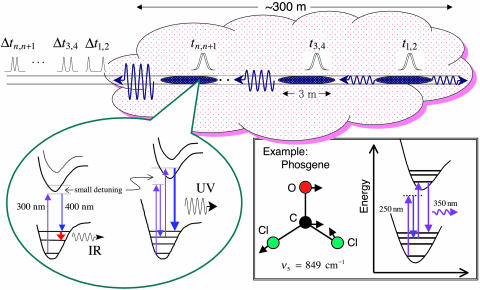Fig. 1.
SOS spectroscopy. Multiple pairs of pulses are generated such that the spacing between pulses in each pair is decreasing. The second pulse in each pair has a higher velocity because of atmospheric dispersion. The first pair of pulses overlaps near the back of the cloud, creating a small region of gain. Subsequent pairs overlap at closer and closer regions of the cloud, producing a swept-gain amplifier that lases back toward the observer. We suggest two schemes: one in which blue and UV pulses are sent toward the cloud, causing lasing on an IR vibrational transition, and the other in which IR and UV pulses are sent toward the cloud, causing lasing on a blue electronic transition (such as the example shown in phosgene).

